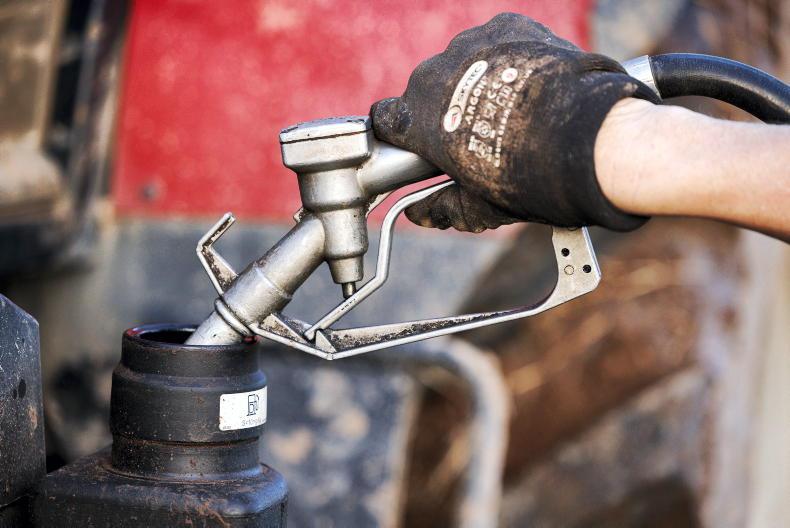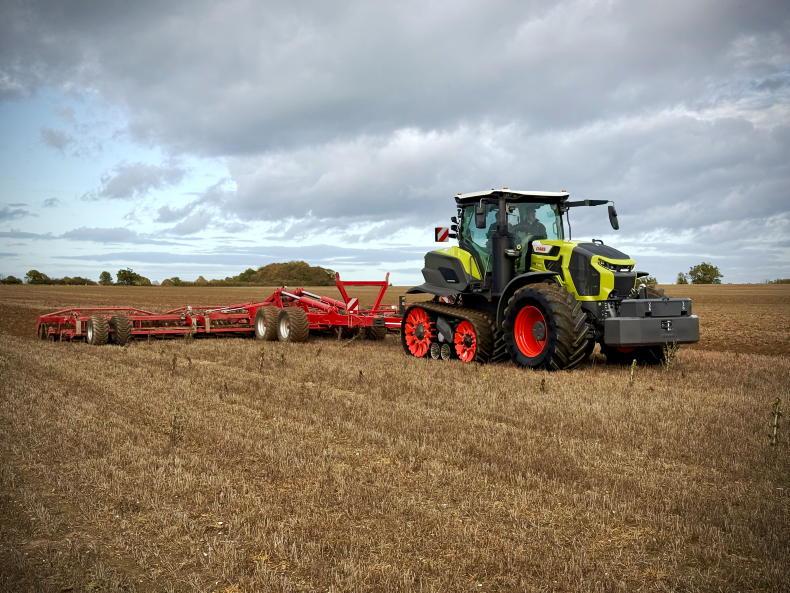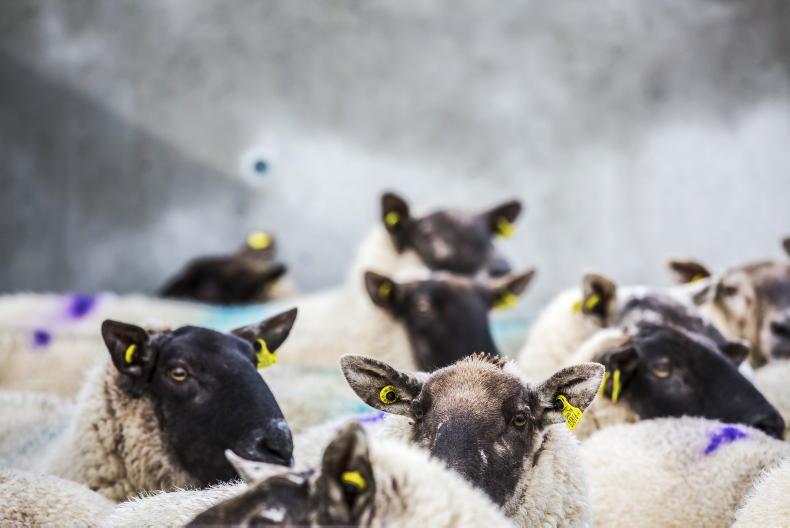When it comes to spreading fertiliser, setting up the mechanical aspect of the machine is important, but understanding the product you are spreading and its characteristics are equally as important.
More and more farmers are moving towards using protected urea.
For those not used to spreading it, it’s important to understand that the characteristics of protected urea are much different to those of CAN and other NPK fertilisers.
It’s a lighter product so it’s less dense. This is why the same size bulk bags are 375kg and not 500kg.
Therefore, when you throw two fertilisers with the same degree of force, the CAN or NPK fertilisers will travel a much further distance than the
urea.
To spread protected urea the same distance, adjustments need to be made to the spreader settings.
Getting the basics right
The first thing to do before attaching the spreader is to measure that both drop arms on the tractor are the same length. Check that the pressure in both rear tyres is equal. An unlevel spreader will have an effect on the spread pattern.
Once mounted on the tractor, ensure both stabilisers are tight, allowing no lateral movement. Ensure that the spreader is mounted at the centre of the tractor’s track width.
Once this is complete, raise the spreader to the correct working height. The general rule of thumb is to have a distance of 75cm from the top of the crop to the spreading mechanism. Next, adjust the toplink to the angle advised by either the spread chart or manufacturer.
Vane settings
Ensure the machine is in good mechanical working order, especially the spreading vanes. Signs of wear are usually seen as waves or holes worn into the vanes. Any issue here will have a big effect on the spreader’s performance.
It is very important to check the angle of the vanes – they may need to be adjusted to suit the fertiliser being spread. Check for wobbles in the discs and agitators, as bearings can wear out over time.
Depending on the manufacturer and spreader model, vane position may go unchanged when switching between NPK and CAN fertilisers. However, it should not be assumed that this is the same for urea-based products.
Most manufacturers offer a calibration/spread chart app for modern machines. These apps are easily used and require the following criteria; application rate, product type, flow rate, spreading width, forward speed, etc. It will then indicate the specific vane position, shutter/regulator position, PTO speed and, in some cases, fertiliser drop point and hopper angle for the specific product application.
Flow rate
It’s vital to check the flow rate of the fertiliser. Different fertilisers will naturally flow at different rates, so the shutter position for 125kg/ha of urea will be different to the shutter position for 125kg/ha of CAN. The flow rate of specific fertiliser will vary between brands, so it’s important to establish the flow rate for the specific product being spread on the day.
This is done by removing one of the discs and placing a bucket under the shutter outlet. Run the tractor PTO, then open the shutter for 30 seconds and collect the fertiliser in the bucket. Check the amount collected against the fertiliser spreader app for your spreader.
If there is no app for your spreader, then you can use the Teagasc online calculator to work out how much fertiliser should have been collected. Adjust the shutter position until the correct amount is reached.
Wagtail spreader
Wagtail spreaders require no further setting up once mounted correctly and the flow rate has been established. This is done using the regulator, and again depends on the working width (m), application rate (kg/ha), forward speed (km/h) and type of fertiliser being applied.
Again, most manufacturers have apps that allow you to input these variables along with the fertiliser type. The app will then provide you with a setting or spread chart to suit the fertiliser being used, granular or prilled etc.
The calibration procedure for a wagtail is almost the same to that of a disc machine. You remove the spout and fit on a calibration container. The app or spread chart will provide a rate in kg/min which should match that coming from the spreader.
Run the spreader at the setting recommended by the app or spread chart and then weigh the fertiliser that comes out over the course of the minute. If the two figures don’t match, some fine-tuning may be required.
Application accuracy
To be straight about it, unless using a GPS of some kind, many farmers will apply fertiliser with a wagtail more accurately than with a twin disc machine. When using a wagtail spreader with a typical working width in the region of 10-12m, it’s easier to maintain an accurate bout width by eye.
Working with wider bout widths such as 18-24m or in a recently cut field makes it much more difficult to maintain accuracy. A basic GPS guidance system is a good investment for farmers who spread their own fertiliser. These systems help to cut out overlapping and reduce fertiliser usage.
Fertiliser density
Granule density represents the mass to volume ratio of granules. This is a measure of the physical weight of one litre of fertiliser measured by a weighing scale.
Urea is a low-density fertiliser with a granule density of 0.75kg/l compared to CAN (27%) with a higher density of 1kg/l. This will impact spreading width and, as a result, the overall spread pattern if not accounted for.
Tray testing
The final step to perfecting the spreading process is to carry out a tray test. It’s great practice to set up the machine to manufacturer’s requirements based on the variables inputted. However, in order to prove the setup procedure is accurate, a tray test would ideally be carried out in the field. To do so, set out the trays at equal distance across the full bout width.
Run the spreader over the trays in three passes, far left, centre and far right to ensure full spread pattern is recorded. Then, collect fertiliser in measuring cylinders and compare.
Spreaders must be mounted correctly and be in good mechanical working order.
Bulk density of protected urea is not the same as CAN and other NPK products. Urea is a low-density fertiliser with a granule density of 0.75kg/l compared to CAN (27%) with a higher density of 1kg/l.Calculating fertiliser flow rate is vital for accurate spreader calibration. Different fertilisers will flow at different rates, so the shutter position for 125kg/ha of urea will be different to the shutter position for 125kg/ha of CAN.A tray test should be carried out to confirm spreader accuracy. 
Collect the fertiliser in measuring cylinders and compare.
When it comes to spreading fertiliser, setting up the mechanical aspect of the machine is important, but understanding the product you are spreading and its characteristics are equally as important.
More and more farmers are moving towards using protected urea.
For those not used to spreading it, it’s important to understand that the characteristics of protected urea are much different to those of CAN and other NPK fertilisers.
It’s a lighter product so it’s less dense. This is why the same size bulk bags are 375kg and not 500kg.
Therefore, when you throw two fertilisers with the same degree of force, the CAN or NPK fertilisers will travel a much further distance than the
urea.
To spread protected urea the same distance, adjustments need to be made to the spreader settings.
Getting the basics right
The first thing to do before attaching the spreader is to measure that both drop arms on the tractor are the same length. Check that the pressure in both rear tyres is equal. An unlevel spreader will have an effect on the spread pattern.
Once mounted on the tractor, ensure both stabilisers are tight, allowing no lateral movement. Ensure that the spreader is mounted at the centre of the tractor’s track width.
Once this is complete, raise the spreader to the correct working height. The general rule of thumb is to have a distance of 75cm from the top of the crop to the spreading mechanism. Next, adjust the toplink to the angle advised by either the spread chart or manufacturer.
Vane settings
Ensure the machine is in good mechanical working order, especially the spreading vanes. Signs of wear are usually seen as waves or holes worn into the vanes. Any issue here will have a big effect on the spreader’s performance.
It is very important to check the angle of the vanes – they may need to be adjusted to suit the fertiliser being spread. Check for wobbles in the discs and agitators, as bearings can wear out over time.
Depending on the manufacturer and spreader model, vane position may go unchanged when switching between NPK and CAN fertilisers. However, it should not be assumed that this is the same for urea-based products.
Most manufacturers offer a calibration/spread chart app for modern machines. These apps are easily used and require the following criteria; application rate, product type, flow rate, spreading width, forward speed, etc. It will then indicate the specific vane position, shutter/regulator position, PTO speed and, in some cases, fertiliser drop point and hopper angle for the specific product application.
Flow rate
It’s vital to check the flow rate of the fertiliser. Different fertilisers will naturally flow at different rates, so the shutter position for 125kg/ha of urea will be different to the shutter position for 125kg/ha of CAN. The flow rate of specific fertiliser will vary between brands, so it’s important to establish the flow rate for the specific product being spread on the day.
This is done by removing one of the discs and placing a bucket under the shutter outlet. Run the tractor PTO, then open the shutter for 30 seconds and collect the fertiliser in the bucket. Check the amount collected against the fertiliser spreader app for your spreader.
If there is no app for your spreader, then you can use the Teagasc online calculator to work out how much fertiliser should have been collected. Adjust the shutter position until the correct amount is reached.
Wagtail spreader
Wagtail spreaders require no further setting up once mounted correctly and the flow rate has been established. This is done using the regulator, and again depends on the working width (m), application rate (kg/ha), forward speed (km/h) and type of fertiliser being applied.
Again, most manufacturers have apps that allow you to input these variables along with the fertiliser type. The app will then provide you with a setting or spread chart to suit the fertiliser being used, granular or prilled etc.
The calibration procedure for a wagtail is almost the same to that of a disc machine. You remove the spout and fit on a calibration container. The app or spread chart will provide a rate in kg/min which should match that coming from the spreader.
Run the spreader at the setting recommended by the app or spread chart and then weigh the fertiliser that comes out over the course of the minute. If the two figures don’t match, some fine-tuning may be required.
Application accuracy
To be straight about it, unless using a GPS of some kind, many farmers will apply fertiliser with a wagtail more accurately than with a twin disc machine. When using a wagtail spreader with a typical working width in the region of 10-12m, it’s easier to maintain an accurate bout width by eye.
Working with wider bout widths such as 18-24m or in a recently cut field makes it much more difficult to maintain accuracy. A basic GPS guidance system is a good investment for farmers who spread their own fertiliser. These systems help to cut out overlapping and reduce fertiliser usage.
Fertiliser density
Granule density represents the mass to volume ratio of granules. This is a measure of the physical weight of one litre of fertiliser measured by a weighing scale.
Urea is a low-density fertiliser with a granule density of 0.75kg/l compared to CAN (27%) with a higher density of 1kg/l. This will impact spreading width and, as a result, the overall spread pattern if not accounted for.
Tray testing
The final step to perfecting the spreading process is to carry out a tray test. It’s great practice to set up the machine to manufacturer’s requirements based on the variables inputted. However, in order to prove the setup procedure is accurate, a tray test would ideally be carried out in the field. To do so, set out the trays at equal distance across the full bout width.
Run the spreader over the trays in three passes, far left, centre and far right to ensure full spread pattern is recorded. Then, collect fertiliser in measuring cylinders and compare.
Spreaders must be mounted correctly and be in good mechanical working order.
Bulk density of protected urea is not the same as CAN and other NPK products. Urea is a low-density fertiliser with a granule density of 0.75kg/l compared to CAN (27%) with a higher density of 1kg/l.Calculating fertiliser flow rate is vital for accurate spreader calibration. Different fertilisers will flow at different rates, so the shutter position for 125kg/ha of urea will be different to the shutter position for 125kg/ha of CAN.A tray test should be carried out to confirm spreader accuracy. 
Collect the fertiliser in measuring cylinders and compare.











SHARING OPTIONS